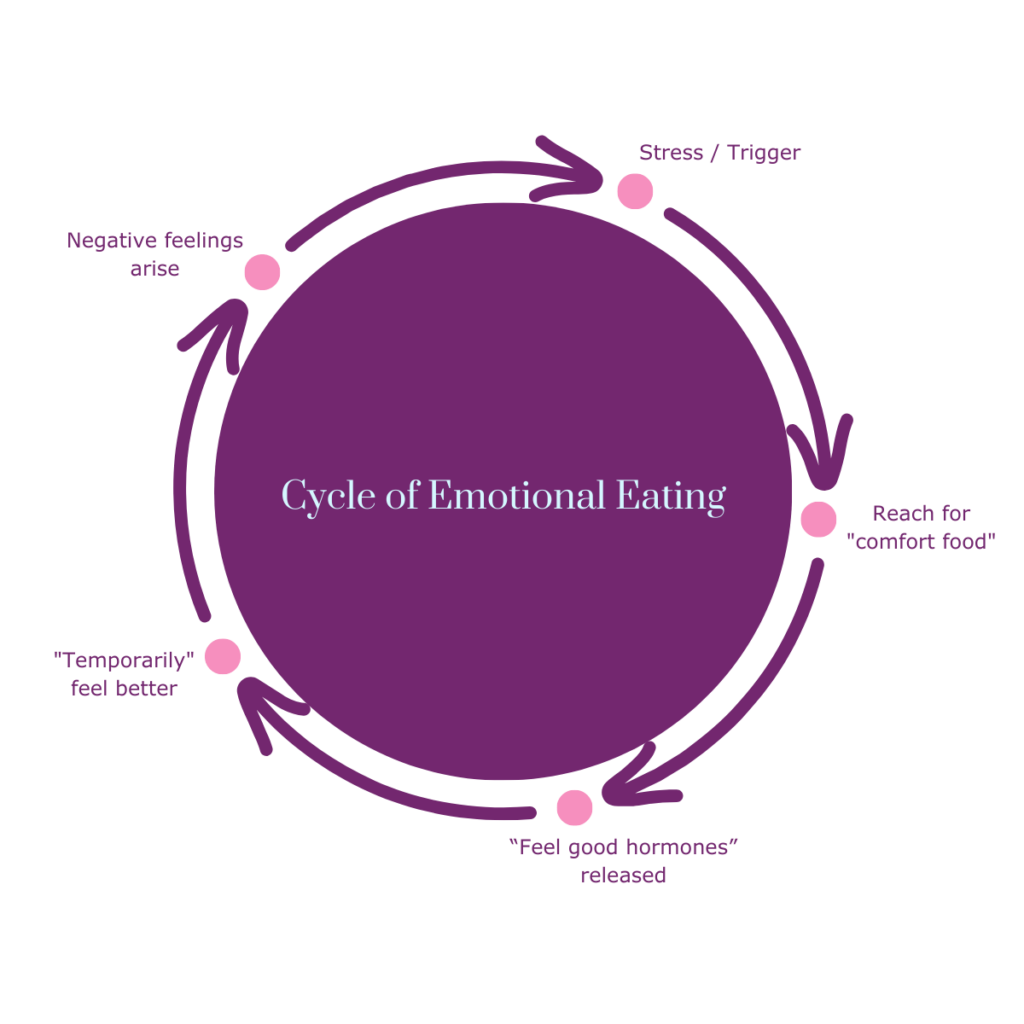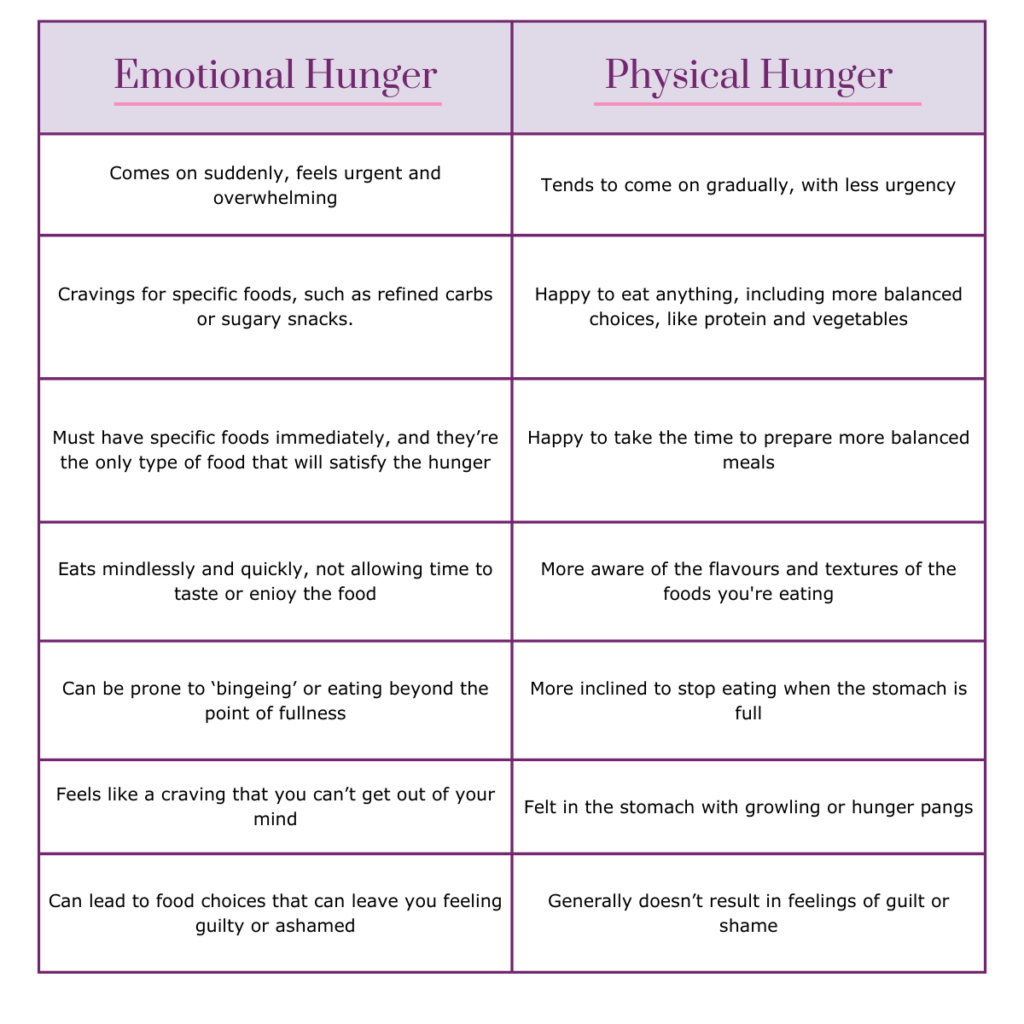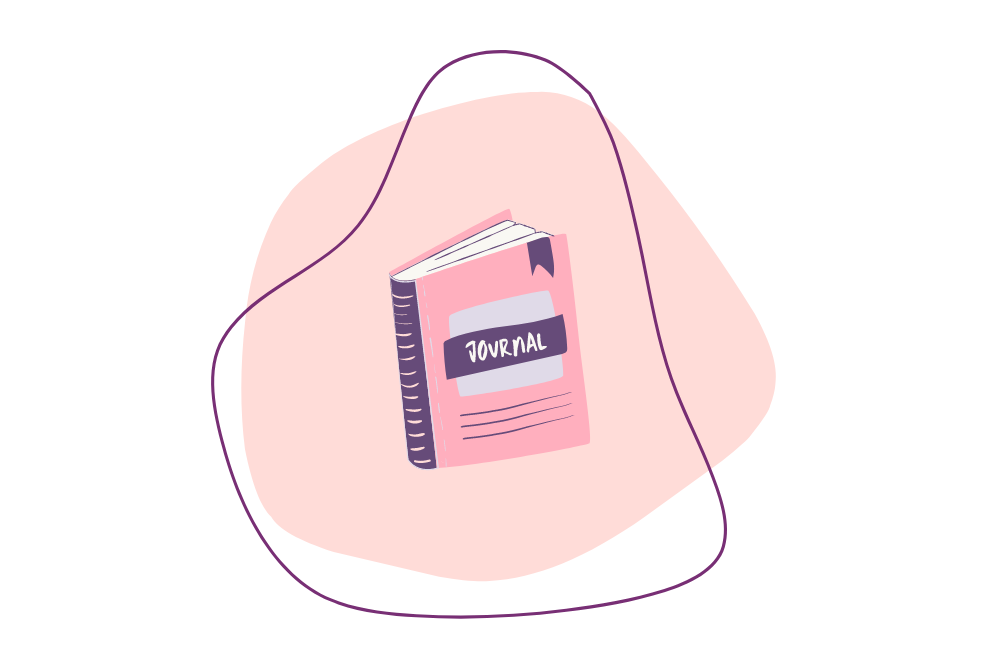Emotions have a bigger impact on eating habits than you may realise. Food isn’t always about satisfying hunger. It’s also tied to how you feel. Whether indulging in your favourite comfort foods when down or sharing a special meal to celebrate, emotions and eating have become close friends. This article takes a closer look at emotional eating, breaking down why it happens, and revealing how the mind, body, and society play a role. By getting a grip on this connection, you can start making healthier choices and build a better relationship with both your food and your feelings.
The Role of Emotions in Food Choices
Emotions can have a big impact on the foods you decide to eat. When you feel stress, sadness, boredom, or happiness, your brain wants to feel better. This can lead you to choose certain foods that you associate with positive emotions or provide temporary relief.
For instance, if stressed, you might go for a bag of chips or an ice cream. These foods can provide a brief moment of comfort. Likewise, when feeling low, you might want sugary or starchy foods. These foods trigger the release of chemicals like dopamine and serotonin – the body’s “feel-good” hormones.
Remember, emotional eating isn’t always a bad thing. Food can be comforting and enjoyable, and it’s fine to treat yourself to your favourite foods sometimes. But as time goes on, the brain learns to seek out foods that make you feel good when you’re not feeling so good. This habit can develop into a pattern where emotional eating becomes the go-to way of dealing with hard emotions.
Common Triggers for Emotional Eating
Emotional Triggers
Emotions can act as powerful triggers that guide food choices. When you’re feeling down or stressed, the allure of comfort foods often becomes irresistible. These comfort foods are typically high in sugar, fat, or salt – elements that trigger a release of “feel-good” chemicals like serotonin and dopamine in the brain. This can create a temporary sense of relief and pleasure, leading to a repeated association between negative emotions and indulgent eating.
Positive emotions can also impact food choices. When you’re happy or celebrating, you might be more inclined to treat yourself to special meals or desserts. Social gatherings and festivities are often centred around food, further solidifying the link between positive emotions and certain types of foods.
The Brain’s Role
Brain chemistry is deeply involved in the connection between emotions and food. The brain’s reward centres respond to the pleasurable sensations of eating, reinforcing the emotional ties to certain foods. This reward response is mediated by neurotransmitters – chemicals that transmit signals between nerve cells.
For instance, when you eat something enjoyable, neurotransmitters like dopamine are released, creating a sensation of pleasure and satisfaction. Over time, the brain learns to associate these positive feelings with specific foods, leading to a cycle of turning to these foods when seeking emotional comfort.
How Society Shapes Emotional Eating
The influence of culture and society cannot be underestimated when looking into emotional eating patterns. Many cultures have rituals and traditions that involve specific foods tied to emotional events. Family gatherings, holidays, and religious ceremonies often revolve around meals, embedding emotions deeply into dietary habits.
Moreover, advertising and media contribute to the emotional connection with food. Advertisements often portray indulgent foods as sources of happiness and enjoyment, further reinforcing the link between emotions and eating. The constant exposure to such messages can subconsciously encourage emotional eating, as the brain associates these foods with positive feelings.
Chronic Stress
Chronic stress, whether stemming from work, personal challenges, or daily pressures, is a significant trigger for emotional eating. During stressful times, many people turn to high-calorie, high-sugar, or high-fat comfort foods as a way to find relief. These foods stimulate the brain’s reward centres, momentarily alleviating stress and generating a sense of comfort. The association between stress and comfort eating can become a cycle that’s hard to break.

How Emotional Eating Impacts Well-being
Emotional eating, while offering temporary relief, can have significant consequences on both physical health and emotional well-being. Understanding these impacts is essential for breaking the cycle of using food as a coping mechanism. Here’s how emotional eating can affect different aspects of well-being:
Physical Health: The Toll on the Body
Emotional eating often involves consuming foods that are high in sugar, unhealthy fats, and empty calories. Over time, this can lead to weight gain, obesity, and related health issues like diabetes, heart disease, and hypertension. These conditions can deteriorate overall physical health and increase the risk of chronic illnesses, affecting longevity and quality of life.
Natural Hunger and Fullness Cues
Emotional eating disrupts the body’s ability to recognise genuine hunger and fullness cues. When you eat in response to emotions rather than true physical hunger, it can be easy to lose touch with your body’s natural signals. This can result in overeating or undereating, leading to unhealthy eating patterns and difficulty maintaining a balanced diet.
Emotional Well-being
While emotional eating provides momentary relief from stress, sadness, or boredom, it often exacerbates emotional distress in the long run. The initial comfort derived from indulging in comfort foods is fleeting, and the guilt, shame, or regret that follows can contribute to a negative emotional cycle. This, in turn, may lead to a reliance on food for emotional support, perpetuating an unhealthy relationship with eating.
Body Image and Self-Esteem
Emotional eating can have a detrimental impact on body image and self-esteem. Weight gain resulting from emotional eating can lead to dissatisfaction with one’s physical appearance, contributing to lower self-esteem and a negative self-image. This can further fuel emotional eating as a way to cope with these negative feelings, creating a harmful cycle.
Identifying Physical and Emotional Hunger
Do you ever have trouble telling if you’re really hungry or if you just want to eat because of how you’re feeling? Knowing the difference between eating because of your emotions and eating because you’re truly hungry is key to having a better relationship with food.
Emotional hunger can pop up suddenly and feel like something you really have to do right away. It happens when you feel stress, boredom, sadness, or even happiness. When you’re emotionally hungry, you usually want specific comfort foods that make you feel better for a little while. It’s like really wanting to eat something particular, even if you’re not really hungry for food.
On the other hand, physical hunger comes on more slowly and might feel like an empty or hungry feeling in your stomach. It’s your body telling you it needs energy and nutrients. Physical hunger isn’t connected to specific feelings, and you can satisfy it with different kinds of foods.
To figure out if you’re emotionally hungry, it can help to stop and think for a moment. Ask yourself if a certain feeling is making you want to eat. Take a little time to consider if you’re actually hungry or if you’re turning to food to deal with your emotions. Emotional hunger often goes away when you find other ways to handle your feelings. But when you’re physically hungry, that feeling doesn’t go away until you eat something nutritious.
When you pay more attention to what your body tells you and understand if you’re emotionally or physically hungry, you can make smarter choices about when and what to eat. So, the next time you’re reaching for food, take a moment to check in with yourself. Ask if you really need food or if there are better ways to deal with your emotions without eating.

Emotional Eating Patterns
Recognising and understanding emotional eating patterns is essential for taking control of your relationship with food and emotions. By using effective tools and strategies, you can shed light on your triggers and make informed choices. Here are two valuable methods to help identify emotional eating patterns:
The Hunger-Fullness Cue Scale: Listening to Your Body
Learning to differentiate between emotional hunger and physical hunger is a fundamental step in identifying emotional eating patterns. The hunger-fullness cue scale is a tool that can help you gauge your hunger levels and make conscious eating decisions.
- Physical Hunger (Genuine Hunger): This is when your body genuinely needs nourishment. You might experience physical sensations like a rumbling stomach, low energy, or irritability. Eating in response to physical hunger tends to lead to satisfying, moderate eating.
- Emotional Hunger (False Hunger): Emotional hunger, on the other hand, is triggered by emotions rather than genuine physical needs. It might come on suddenly, and you might crave specific comfort foods. Emotional eating tends to be impulsive and might lead to overeating.
Using the hunger-fullness cue scale, you can rate your hunger level on a scale of 1 to 10, with 1 being extremely hungry and 10 being overly full. Paying attention to these cues before, during, and after meals can help you become more attuned to your body’s signals and make mindful eating choices.
Keeping a Food and Mood Journal: Insight into Emotional Triggers
A food and mood journal is a powerful tool for uncovering emotional eating patterns. It involves recording not only what you eat but also how you feel before and after eating. Here’s how to effectively maintain a food and mood journal:
- Record Meals: Document everything you eat and drink, including portion sizes and snacks.
- Note Emotions: Jot down how you’re feeling emotionally before eating. Are you stressed, happy, sad, or bored?
- Track Triggers: After eating, make a note of how you feel. Did your mood change? Did you feel guilty, satisfied, or regretful?
- Identify Patterns: Over time, look for patterns in your journal. Do you notice that you tend to eat more during times of stress? Are certain emotions consistently linked to specific foods?
By tracking your food and emotions, you can uncover patterns and gain insights into your emotional eating triggers. This awareness is the first step towards developing healthier coping mechanisms and making more intentional choices about when and what to eat.

Breaking the Cycle: Strategies to Combat Emotional Eating
Emotional eating can be a challenging cycle to break, but with dedication and the right strategies, it’s possible to regain control over your eating habits and emotions. Here are effective techniques to help combat emotional eating and foster a healthier relationship with food:
Mindful Eating: Engage Your Senses
Mindful eating involves paying full attention to your eating experience. Slow down and savour each bite, noticing the textures, flavours, and smells. This practice helps you connect with your body’s cues of hunger and fullness, preventing impulsive and emotional eating.
Emotion Regulation Techniques: Find Alternatives
Instead of turning to food, explore other ways to manage emotions. Engage in activities that bring joy or relaxation, such as reading, listening to music, taking a walk, or practising deep breathing. These alternatives can help soothe emotions without relying on food.
Pause Before Eating: Assess Your Hunger
Before eating, take a moment to evaluate your hunger level. Use the hunger-fullness cue scale to determine if you’re truly hungry or if emotions are driving your desire to eat. This pause gives you the opportunity to make conscious choices.
Keep a Support System: Stay Connected
Share your goals with friends, family, or a support group. Having a network of people who understand your challenges can provide encouragement and accountability. They can also serve as a source of distraction when emotional cravings strike.

Create a Structured Eating Routine: Consistency is Key
Establish regular meal times and stick to a structured eating routine. This can help regulate your body’s hunger and fullness cues, reducing the likelihood of impulsive eating driven by emotions.
Food Journaling: Track Triggers and Progress
Maintain a food journal to track your meals, emotions, and triggers. Over time, you’ll gain insights into patterns that lead to emotional eating. This awareness can empower you to make targeted changes to your habits.
Seek Professional Help: Expert Guidance
If emotional eating is significantly impacting your well-being, consider reaching out to a therapist, counsellor, or registered dietitian. They can help you address the emotional roots of your eating habits and provide tailored strategies for managing them.
Practice Self-Compassion: Be Kind to Yourself
Don’t be too hard on yourself if you slip up. Breaking the cycle of emotional eating takes time and effort. Treat yourself with kindness and understanding, and view setbacks as opportunities to learn and grow.
Set Realistic Goals: Take Small Steps
Set achievable goals for managing emotional eating. Instead of aiming for perfection, focus on gradual progress. Celebrate each successful step you take towards healthier habits.
Celebrate Non-Food Achievements: Reward Yourself Differently
Reward yourself for accomplishments that don’t involve food. Treat yourself to a relaxing bath, a new book, or a day of self-care. This helps shift the association between positive emotions and eating.
Breaking the cycle of emotional eating requires patience, self-awareness, and commitment. By incorporating strategies like mindful eating, seeking alternatives for emotional comfort, and creating a structured routine, you can take control of your eating habits and emotions. Remember that each step towards healthier habits is a step towards greater well-being and a more balanced relationship with food.







